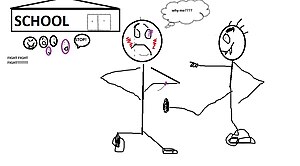Suicide so often “comes as a surprise” to those left behind, but in all honesty, the signs
were more than likely always there. The identifying factors that lead up to this type of tragedy are many, but in our busy, multitasking lives, we tend to overlook them or dismiss them as part and parcel to growing up, particularly the subtle hints. While I can’t speak for most kids or adults, I can tell you that the inner turmoil which occurs in the mind of someone who’s suffering from suicidal thoughts is akin to severe emotional isolation—with it comes the delusion that one is “the other,” so different from those around them, they can’t even begin to integrate. Often times, those who are bullied struggle with suicidal ideation. Often times, no one even knows.
Of late, there have been several anti-bullying videos, songs, as well as organizations who are ardently amping up their efforts to bring awareness to this issue. It’s not that bullying in and of itself is tantamount to suicide, but those that are bullied often get to a place emotionally where they simply give up trying. If drugs and alcohol can’t numb the pain, or if cutting can’t raise the endorphins enough to eradicate one’s uncomfortable emotions, then suicide suddenly can look like an option. According to the National Institute of Mental Health (NIMH) and the CDC, “Nearly five times as many males as females ages 15-19 died by suicide,” and “Just under six times as many males as females ages 20-24 died by suicide.” Risk factors for suicide attempts include things like:
- Depression and other forms of mental illness
- Addiction;
- A family history of mental disorders or substance abuse;
- Family history of suicide;
- History of physical or sexual abuse;
- Firearms in the home
- Incarceration
- Exposure to suicidal behavior of others (family members, friends, media)
It’s important to note, however, that suicide is an extreme reaction to stress. There are many people in and out of recovery who can check off many of the above factors but are not suicidal. Regardless, the risks are notable and should be viewed with great concern and scrutiny.
I remember being a teen and feeling isolated and very much like “the other.” The irony is, the one and only time I was directed to the suicide hotline, I wasn’t actually suicidal. I was just a surly teen. Later, however, the internal dialogue of self-loathing and lack of self-worth drove me to put myself in more and more unsafe places. It wasn’t until many 4th steps later when I realized my actions were not only a cry for help, they were, in fact a means of subversive suicidal ideation. As a teen, I needed my parents and didn’t have them, either due to their emotional unavailability or their absence. As a parent myself, I have learned that despite the adolescent, parent-hating bluster, I am needed—we are needed. A child who can come home and talk openly to a parent is, in my opinion, less likely to revert inward. Talking about being bullied, asking for help, and getting it, is invaluable, and we, as parents, need to provide the environment in which our kids can safely do that. If not, then we risk being left behind, drowning in grief and unanswerable questions.
**If you or someone you know is thinking about or talking about suicide,take it seriously. You can call the National Suicide Prevention Lifeline at 1-800-273-TALK (8255). It is available 24/7.
Originally posted on December 9, 2011 @ 10:49 pm






